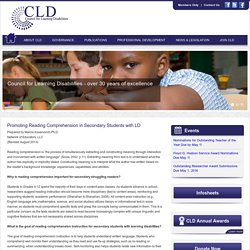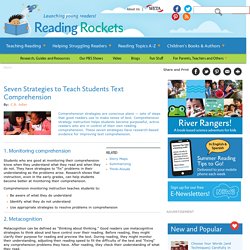

LINCS. Graphic Organizer (Reading) Cornell Notes. Improving Comprehension for Students with LD. By: Joanna P.

Williams Twenty years ago, research on the reading comprehension problems of students with learning disabilities focused on their difficulties with decoding text. Today, though, researchers view such problems as arising from difficulties across a wide range of language and thinking activities (Swanson and Hoskyn, 1998). They recognize that some students have mastered the mechanics of reading but still have comprehension problems.
This type of problem may not be evident until the higher grades when comprehension challenges increase. Although students with learning disabilities may have the ability to process information, they do so with great inefficiency. These are difficulties of strategic processing and metacognition (Gersten, Williams, Fuchs and Baker, 1998). Research shows that instruction can improve students' strategic processing of text. Teaching students how to comprehend narrative text However, students with learning disabilities are slower to develop this ability. Promoting Reading Comprehension in Secondary Students with Learning Disabilities. Prepared by Marcia Kosanovich,Ph.D.

Network of Educators, LLC (Revised August 2013) Reading comprehension is “the process of simultaneously extracting and constructing meaning through interaction and involvement with written language” (Snow, 2002, p.11). Extracting meaning from text is to understand what the author has explicitly or implicitly stated. Constructing meaning is to interpret what the author has written based on the reader’s background knowledge, experiences, capabilities, and abilities.
Why is reading comprehension important for secondary struggling readers? Students in Grades 4-12 spend the majority of their days in content-area classes. Visit Us to Improve The Comprehension Reading Strategies. What clicked?

What clunked? Imagine asking students these questions about reading comprehension. Will students love it? Many will and some might not, but you’re certainly more likely to intrigue young readers with “click” and “clunk” than with other traditional reading comprehension questions. Using click or clunk is part of 5 strategies for improving reading comprehension, from the book, Now We Get It! Much of the guided reading that dominates some classes is boring and can kill the joy of reading. Are you using Click and Clunk or similar reading comprehension strategies in your classroom? Find more education infographics on e-Learning Infographics and in the Brilliant or Insane infographics library. Also on Brilliant or Insane About The Author markbarnes19 Mark Barnes is the author of many education books, including Bestseller Hacking Education, part of his Hack Learning Series, books that solve big problems with simple ideas.
Pearson Prentice Hall: eTeach: Strategies for Improving Reading Comprehension. By Patricia Babbitt Introduction Most Effective Strategies Practical Applications of Reading Strategies Summary Resources Remember the adventures that lived and breathed between the pages of a really good book when, as a young reader, you slipped away undiscovered into your own magical world?

My favorite works were Charlotte's Web, Arabian Nights, Huckleberry Finn, Arthurian Legends, and, later, the timeless tragedy of William Shakespeare's Hamlet. It is no surprise that many of us who loved such adventures grew up to become today's English teachers and writers. The surprise comes when we discover how many of our own students are struggling readers. But surprise need not lead to a permanent state of frustration. Theoretically speaking, if the daily reading curriculum uses research-proven methods, students should develop skills for comprehending the text. Comprehension monitoring Post-reading: Summarizing (see below) is an effective strategy that can take many different forms.
Explain why…. Seven Strategies to Teach Students Text Comprehension. 1.

Monitoring comprehension Students who are good at monitoring their comprehension know when they understand what they read and when they do not. They have strategies to "fix" problems in their understanding as the problems arise. Research shows that instruction, even in the early grades, can help students become better at monitoring their comprehension. Comprehension monitoring instruction teaches students to: Be aware of what they do understand Identify what they do not understand Use appropriate strategies to resolve problems in comprehension 2. Metacognition can be defined as "thinking about thinking.
" Students may use several comprehension monitoring strategies: Identify where the difficulty occurs "I don't understand the second paragraph on page 76. " 3. Graphic organizers illustrate concepts and relationships between concepts in a text or using diagrams. Regardless of the label, graphic organizers can help readers focus on concepts and how they are related to other concepts. 4. 5.